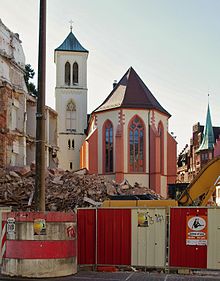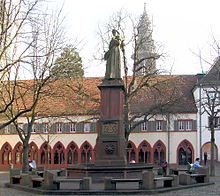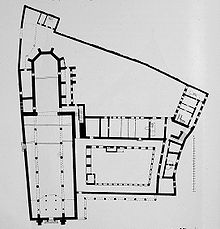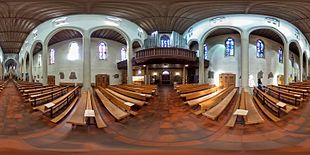St. Martin (Freiburg Old Town)


The Church of St. Martin (also known as Martinskirche or St. Martinskirche ) is a Roman Catholic parish church on Rathausplatz in Freiburg's old town and the Dominican convent church . It is consecrated to St. Martin and was built as a monastery church of a Franciscan convent.
history
The church was built for the Franciscans who had settled in Freiburg around 1226 - initially in one of the suburbs. Due to the strong increase in friars, the order decided to build another convent in the city , and in 1246 Conrad I, a count of Freiburg , gave the St. Martin's Chapel, which was documented as early as 1206, and other land. When the chapel became too small, it was replaced by a church that encompassed the space of the current choir . Parts of a Romanesque cornice of the first chapel were found during restoration work in the choir. It is documented that the Franciscans acquired another property in 1262. The cloister , which is still partially preserved today, was built during this time . At that time, the Franciscans were strongly encouraged from various directions, so that the city council prohibited the further purchase of land. The choir was completed in 1286. The nave was not completed until 1318; in order to respect the property boundaries, the north wall of the aisle was bent . Bishop Tillmann of Basel consecrated the church anew in 1518.
After the Thirty Years War , extensive repairs had to be made. The interior was redesigned in baroque style . In the following time some equipment was added to the church. The church was badly damaged during the French siege in 1713/14. This damage was repaired in 1721/24, with the interior being redesigned with a stucco ceiling by Franz Joseph Vogel . As early as 1719, a baroque portal was created on the west side, on the gable of which there is an Immaculate statue between the two religious saints Francis of Assisi and Antonius of Padua . In 1775 Trudpert Walter added the tabernacle . From 1785 the church is said to have also been a parish church, but this is controversial. Paintings, statues and the Nepomuk altar were taken over from the abolished Freiburg Preacher Church in 1792.
From 1807 the de-baroque of the church began, which was promoted by Pastor Biechele, who wanted to bring “brightness, harmony, beauty and religious simplicity” into the church. Some of the baroque altars were removed in 1816/21, the floor was repaired with stone slabs from the Freiburg Minster . In 1845, monastery buildings in the south and part of the cloister were demolished, creating Freiburg's town hall square. In 1875/76 the archbishop's building department under Lukas Engesser cleared out the interior and redesigned it in a neo-Gothic style. The rococo high altar was also removed and the choir windows opened again. In the following years, 1877/79, the Marienkapelle was set up as a confessional and baptistery, which was followed by glass paintings on the windows in 1880/81 and a new organ in 1882. The highlight of the historicizing redesign was the erection of the church tower in the years 1890–1893 by the Freiburg architect Max Meckel . Until then, the church as a mendicant order church had only one roof turret . The church tower and today's high altar go back to the work of Heinrich Hansjakob , the most famous pastor of the church, who held the office from 1884 to 1913. Heinrich Hansjakob is better known as a local writer than as a pastor.
The neo-Gothic furnishings were lost in the air raid on Freiburg on November 27, 1944 : the church caught fire due to phosphorus bombs and the spire fell into the nave. The burnt-out building was rebuilt in 1949–1951 and re-consecrated on St. Martin's Day in 1951. In 1974/1975 the church building was fundamentally renovated, with the tower also being given a new roof: the high spire was no longer used, but the flat pyramid roof of the reconstruction was replaced by a steeper pyramid shape.
Since 2009 the Dominicans have taken on pastoral care in the church, which marked the beginning of a new phase of church work. On February 10, 2012, the St. Martin Convent was established. The church is also home to the Ukrainian Greek Catholic parish of St. Josaphat, which can also be seen on several icons in the church area.
After Easter 2017 the church was closed and the interior was renovated for 750,000 euros until the patronage on November 12th. The organ was also expanded, which is to be replaced by a new instrument with 45 registers on three manuals and pedal by the Johannes Klais Orgelbau workshop by September / October 2020 . Meanwhile, an electronic organ sounds. Walls and pillars have been repainted, the acoustics have been improved and the electrics have been renewed. The church is now illuminated with LEDs.
Furnishing
The interior of the church, including the choir, is 65 m long, 17.50 m wide with the two side aisles and a height of almost 12 m at the nave. The simple, bright central nave, which is flanked by two less high side aisles, is illuminated by lancet windows with simple tracery in the side aisles and a high window in the western front and is spanned by a flat wooden ceiling. The choir, on the other hand, is vaulted. Remains of paintings from the 14th century can still be seen in the front nave. A painting fragment depicting Saint Martin comes from the Freiburg Minster and was installed in St. Martin's Church in 1975. The glazing of the choir windows based on designs by the Freiburg glass painter Eduard Stritt dates from 1919, the other windows were redesigned in the 1950s.
The high altar, a replica of the altar in Doberan Minster , was consecrated on January 23, 1887. The design and the execution of the panel paintings come from the painter Martin von Kiedrich . The execution of the shrine and carving comes from the sculptor Josef Eberle from Überlingen. The angelic figures of the predella making music were modeled on those from Oberwesel . The two high reliefs in the shrine depict the wedding at Cana and the multiplication of bread in the desert. The inner wing images illustrate the sacrifices of Melchizedech and Isaac as well as the Manna rain and the Easter lamb . On the outer wing of the wing you can see the Saints Augustine , Sebastian , Martin and Francis of Assisi on the right, Elisabeth, Klara, Barbara and Katharina on the left.
organ
The organ building companies Klais (Bonn) and Manufacture d'Orgues André Thomas (Ster Francorchamps, Belgium) are currently building a new organ. The instrument will have 47 stops on three manuals and pedal, including some transmissions and extended stops.
|
|
|
|
|||||||||||||||||||||||||||||||||||||||||||||||||||||||||||||||||||||||||||||||||||||||||||||||||||||||||||||||||||||||||||||||||||||||||||||||||||||||||||||
Bells
In 1968, St. Martin received six new Bronze - bells from the bell foundry of Friedrich Wilhelm Schilling of Heidelberg.
| No. | Surname | Weight (kg) |
Diameter (mm) |
Chime |
|---|---|---|---|---|
| 1 | 1567 | 2270 | c 1 | |
| 2 | 1394 | 1875 | d 1 | |
| 3 | 1236 | 1298 | e 1 | |
| 4th | 1106 | 931 | g 1 | |
| 5 | 982 | 654 | a 1 | |
| 6th | 905 | 562 | c 2 |
A seventh, historical bell is in the rectory. It was cast in 1729 by N (icolaus) Rossier (II) and Ioannes Caudrillier. Its diameter is 600 mm and it is tuned to the strike note d "+8. It has no damage that would impair the sounding and could therefore be rung.
Personalities
- Berthold Schwarz is said to have discovered black powder around 1359 in the Franciscan monastery in Freiburg .
- Bernhard Galura , later Prince-Bishop of Brixen (1829-1856), was pastor of St. Martin from 1810 to 1815
- Heinrich Hansjakob , pastor, local writer, historian and politician, was the parish priest of St. Martin from 1884 to 1913.
- Johann Baptist Knebel , German dean, theologian and honorary canon, was city pastor from 1916 to 1924.
- Franz Philipp , Catholic church musician and composer, worked from 1919 to 1924 as a choir director and organist. During this time he probably composed St. Martin's house master's song, which is still sung in St. Martin today, especially for the patronage festival on November 11th.
literature
- Hermann Brommer : Freiburg i. Br. - St. Martin. Verlag Schnell & Steiner, 2nd, revised edition 1994
- Friedrich Kempf: The parish church of St. Martin and the former Franciscan monastery in: Baden architects and engineers association: Freiburg im Breisgau. The city and its buildings , HM Poppe & Sohn, Freiburg im Breisgau 1898, pp. 343–355,
- Peter Kalchthaler : Freiburg and its buildings. An art-historical city tour. Revised 4th edition. Promo-Verlag, Freiburg 2006, ISBN 3-923288-45-X .
See also
Web links
Individual evidence
- ^ Karl Schmid, Hans Schadek: The Zähringer . Vol. 2: Impulse and Effect . Thorbecke, Sigmaringen 1986, ISBN 3-7995-7041-1 , p. 231.
- ↑ Werner Wolf-Holzäpfel : The architect Max Meckel 1847-1910. Studies on the architecture and church building of historicism in Germany . Kunstverlag Josef Fink, Lindenberg 2000, ISBN 3-933784-62-X , p. 348 f.
- ^ Ukrainian community Freiburg .
- ^ BZ holiday campaign in St. Martin: Church in transition , Holger Schindler, Badische Zeitung , August 5, 2011.
- ↑ Münster organ concerts - organs of the Catholic churches in Freiburg
- ^ Sina Gesell: Freiburg: Renovation: The Catholic Church of St. Martin on Rathausplatz is being renovated for 750,000 euros. Badische Zeitung, April 24, 2017, accessed on April 24, 2017 .
- ↑ Sina Schuler: The Church of St. Martin - Freiburg - Badische Zeitung opens just in time for Martinsfest. Badische Zeitung, November 10, 2017, accessed on November 10, 2017 .
- ↑ Kempf, p. 352 .
- ↑ Information on the organ
- ↑ Bell inspection of the Archdiocese of Freiburg - Catholic Parish Church of St. Martin in Freiburg (old town)
- ^ Joachim Faller: Franz (Joseph) Philipp. In: Biographisch-Bibliographisches Kirchenlexikon (BBKL). Volume 24, Bautz, Nordhausen 2005, ISBN 3-88309-247-9 , Sp. 1157-1160.
Coordinates: 47 ° 59 ′ 49 ″ N , 7 ° 51 ′ 2 ″ E





